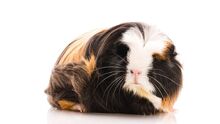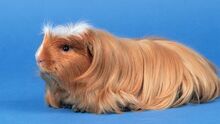

Fur
Bred in England, the Coronet has longhair with one rosette centred on the top of the head. It is similar to the Silkie/Sheltie though the latter is lacking the "coronet" on the top of the head. The Coronet seems to have a flowing mane falling back from the head. It is an emerging breed with smooth fur.
The Coronet was first bred in England in the mid-1970s. It is a cross between the Silkie and an American Crested (Crested with a white crown). It was separately developed in the United States of America using Silkies and non-conforming American Cresteds with longer hair on the rump than accepted. It was first recognised in 1998 by ARBA.
Coronets also come in a satin variety.
Colours
Any eye/fur colours and patterns.
Health & Care
The average lifespan of a Coronet is six to eight years. Because of their long fur, they are not suitable for first-time owners. They need daily brushing and grooming to upkeep their beautiful coats and need to be trimmed when necessary.
Their nails should be trimmed once a month and they should be bathed once a month. When they get dirt and grime in their fur, they should be bathed in a small bowl with lukewarm water to wash away the grit. They should be brushed and detangled afterwards.
Showing
This emerging breed is very popular in guinea pig shows and is quite the showstopper. They should be healthy and an ideal weight for the show. Their fur should be nice and clean, freshly bathed and groomed. You can bring a brush to brush their fur in the correct direction while waiting to be called (yes, Fred is a show guinea pig- this is how I know these things!) and the nails should be freshly trimmed. You can get points taken off for your pig having "flat fur" or "narrow shoulders." (both which Fred has, though he was the only teddy in the show)Personality & Overview
Coronets are playful, curious and affectionate. They crave attention and can be cuddly pets or beautiful show animals.
This breed has a high upkeep and will require more attention than shorter-haired breeds. They are newer and came from Cresteds and Silkies. They are long-haired with a rosette on the top of their foreheads. They live six to eight years and were bred seperately in England and America in the 1970s, first recognised by the ARBA in 1998.
